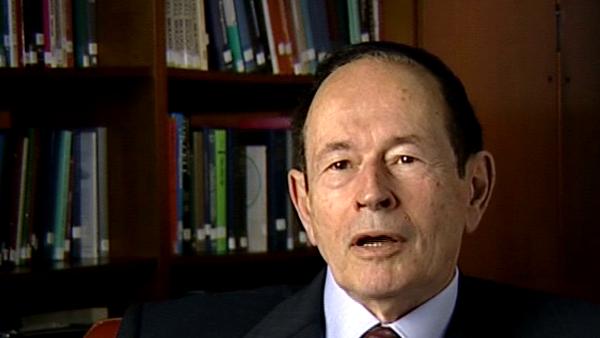NEXT STORY

Lessons learnt from Pauling and Burnet
RELATED STORIES

NEXT STORY

Lessons learnt from Pauling and Burnet
RELATED STORIES



Where was immunology at the time all this was happening? I never looked on myself as an immunologist – in fact I didn't look on myself as anything – but it was more physical chemistry than it was immunology; immunology was the background knowledge, as was medicine. So what did they think? Well, what they thought was what a very brilliant and great chemist Linus Pauling thought –namely, the way the specificity problem was solved... remember the size problem might be solved by cleaving the molecule, the heterogeneity by assuming that you actually have cancer supervening on one cell that makes just one gamma globulin, each different for each patient, and third the specificity problem.
Well, Pauling suggested that the way... and he was a friend of Landsteiner... suggested that the way you recognized these molecules is the foreign molecule came in and then you folded the antibody chain around it and it's sort of like a cookie in a cookie cutter, and then the foreign molecule went away and you were ready for the next time, so it would go like that. That was called the instructional theory, or the instructive theory of antibody formation. It was very powerful in the sense that it was simple, elegant, the way Linus Pauling was in the way he did his theories... turned out it was wrong, but at the time it was the prevalent theory, except for one other gentleman: Macfarlane Burnet.
Macfarlane Burnet was a virologist and epidemiologist from Australia – remarkably broad mind. A friend by the way of René Dubos whom I mentioned before. And Macfarlane Burnet just persistently attempted to understand the specificity problem, and following upon some work of Nils Jerne, that maybe the antibodies all existed beforehand and what they did is brought the foreign molecule to the cell and then made more of the same backwards, which turned out to be a wrong idea. But the idea that it was a selectional system, a natural selectional system, got to Macfarlane Burnet, who finally came up with the idea of the clonal selection theory of antibody formation. So that was the selectional theory as against Pauling's instructional theory. Pauling wasn't the only instructivist but he was the most prominent. Here was Macfarlane Burnet's idea: that each cell – this was the cell that would make a myeloma protein if it got cancerous... each cell would have one antibody on it. He didn't call them antibodies, he called them recognizers. And each one would have a different one, and it would be a repertoire, and you'd make that independent of anything that happened in the outside world, but when you got a foreign molecule in there, the foreign molecule would go down and poll this library and finally hit one that stuck to it, and another that stuck to it, and those would be produced clonally – that is, the cells would divide asexually two to the nth: one, two, four, eight etc. And this idea, which was by no means accepted, was one that Joe Gally and I found enormously attractive and it fit exactly what we said about the myeloma, where instead of stimulating cell division by antigen binding, what happened is a cancer came onto this one cell and made huge amounts of the protein.
US biologist Gerald Edelman (1929-2014) successfully constructed a precise model of an antibody, a protein used by the body to neutralise harmful bacteria or viruses and it was this work that won him the Nobel Prize in Physiology or Medicine in 1972 jointly with Rodney R Porter. He then turned his attention to neuroscience, focusing on neural Darwinism, an influential theory of brain function.
Title: Pauling's instructive theory vs Burnet's selectional theory
Listeners: Ralph J. Greenspan
Dr. Greenspan has worked on the genetic and neurobiological basis of behavior in fruit flies (Drosophila melanogaster) almost since the inception of the field, studying with one of its founders, Jeffery Hall, at Brandeis University in Massachusetts, where he received his Ph.D. in biology in 1979. He subsequently taught and conducted research at Princeton University and New York University where he ran the W.M. Keck Laboratory of Molecular Neurobiology, relocating to San Diego in 1997 to become a Senior Fellow in Experimental Neurobiology at The Neurosciences Institute. Dr. Greenspan’s research accomplishments include studies of physiological and behavioral consequences of mutations in a neurotransmitter system affecting one of the brain's principal chemical signals, studies making highly localized genetic alterations in the nervous system to alter behavior, molecular identification of genes causing naturally occurring variation in behavior, and the demonstration that the fly has sleep-like and attention-like behavior similar to that of mammals. Dr. Greenspan has been awarded fellowships from the Helen Hay Whitney Foundation, the Searle Scholars Program, the McKnight Foundation, the Sloan Foundation and the Klingenstein Foundation. In addition to authoring research papers in journals such as "Science", "Nature", "Cell", "Neuron", and "Current Biology", he is also author of an article on the subject of genes and behavior for "Scientific American" and several books, including "Genetic Neurobiology" with Jeffrey Hall and William Harris, "Flexibility and Constraint in Behavioral Systems" with C.P. Kyriacou, and "Fly Pushing: The Theory and Practice of Drosophila Genetics", which has become a standard work in all fruit fly laboratories.
Tags: Karl Landsteiner, Linus Pauling, Macfarlane Burnet, René Dubos, Nils Jerne, Joe Gally
Duration: 3 minutes, 10 seconds
Date story recorded: July 2005
Date story went live: 24 January 2008